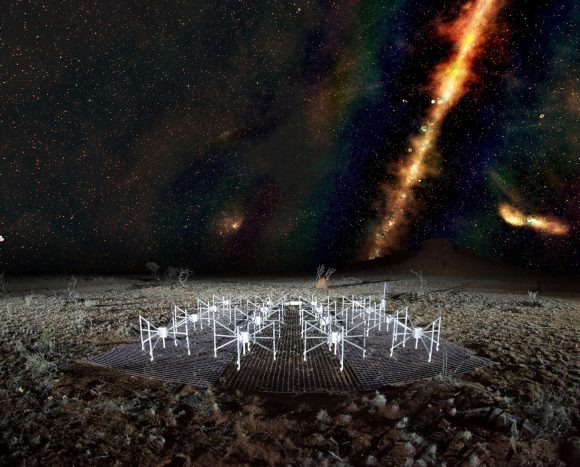

| Online: | |
| Visits: | |
| Stories: |

| Story Views | |
| Now: | |
| Last Hour: | |
| Last 24 Hours: | |
| Total: | |
Galactic Stripping Mystery Uncovered
It’s what you might call a case of galactic homicide (or “galacticide”). All over the known Universe, satellite galaxies are slowly being stripped of their lifeblood – i.e. their gases. This process is responsible for halting the formation of new stars, and therefore condemning these galaxies to a relatively quick death (by cosmological standards). And for some time, astronomers have been searching for the potential culprit.
But according to a new study by a team of international researchers from the International Center for Radio Astronomy Research (ICRAR) in Australia, the answer may have to do with the hot gas galactic clusters routinely pass through. According to their study, which appeared recently in The Monthly Notices of the Royal Astronomical Society, this mechanism may be responsible for the slow death we are seeing out there.
This process is known as “ram-pressure stripping“, which occurs when the force created by the passage of galaxies through the hot plasma that lies between them is strong enough that it is able to overcome the gravitational pull of those galaxies. At this point, they lose gas, much in the same way that a planet’s atmosphere can be slowly stripped away by the effects of Solar wind.

‘Radio color’ view of the sky above the Murchison Widefield Array radio telescope, part of the International Center for Radio Astronomy Research (ICRAC). Credit: Natasha Hurley-Walker (ICRAR/Curtin)/Dr John Goldsmith/Celestial Visions.
For the sake of their study, titled “Cold gas stripping in satellite galaxies: from pairs to clusters“, the team relied on data obtained by the Sloan Digital Sky Survey and the Arecibo Legacy Fast (ALFA) survey. While the SDSS provided multi-wavelength data on 10,600 satellite galaxies in the known Universe, ALFA provided data on the amount of neutral atomic hydrogen they contained.
By measuring the amount of stripping that took place within each, they deduced that the extent to which a galaxy was stripped of its essential gases had much to do with the mass of its dark matter halo. For some time, astronomers have believed that galaxies are embedded in clouds of this invisible mass, which is believed to make up 27% of the known Universe.
As Toby Brown – a researcher from the Center for Astrophysics and Supercomputing at the Swinburne University of Technology and the lead author on the paper – explained:
“During their lifetimes, galaxies can inhabit halos of different sizes, ranging from masses typical of our own Milky Way to halos thousands of times more massive. As galaxies fall through these larger halos, the superheated intergalactic plasma between them removes their gas in a fast-acting process called ram-pressure stripping. You can think of it like a giant cosmic broom that comes through and physically sweeps the gas from the galaxies.”

The Arecibo Observatory in Puerto Rico, where the Arecibo Legacy Fast ALFA Survey is conducted. Credit: egg.astro.cornell.edu
This stripping is what deprives satellites galaxies of their ability to form new stars, which ensures that the stars they have enter their red giant phase. This process, which results in a galaxy populated by cooler stars, makes them that much harder to see in visible light (though still detectable in the infrared band). Quietly, but quickly, these galaxies become cold, dark, and fade away.
Already, astronomers were aware of the effects of ram-pressure stripping of galaxies in clusters, which boast the largest dark matter halos found in the Universe. But thanks to their study, they are now aware that it can affect satellite galaxies as well. Ultimately, this shows that the process of ram-pressure stripping is more prevalent than previously thought.
As Dr. Barbara Catinella, an ICRAR researcher and co-author on the study, put it:
“Most galaxies in the Universe live in these groups of between two and a hundred galaxies. We’ve found this removal of gas by stripping is potentially the dominant way galaxies are quenched by their surroundings, meaning their gas is removed and star formation shuts down.”
Another major way in which galaxies die is known as “strangulation”, which occurs when a galaxy’s gas is consumed faster than it can be replenished. However, compared to ram-pressure stripping, this process is very gradual, taking billions of years rather than just tens of millions – very fast on a cosmological time scale. Also, this process is more akin to a galaxy suffering from famine after outstripping its food source, rather than homicide.
Another cosmological mystery solved, and one that has crime-drama implications no less!
Further Reading: Royal Astronomical Society, MNRAS
The post Galactic Stripping Mystery Uncovered appeared first on Universe Today.
Source: http://www.universetoday.com/133002/galactic-stripping-mystery-uncovered/


